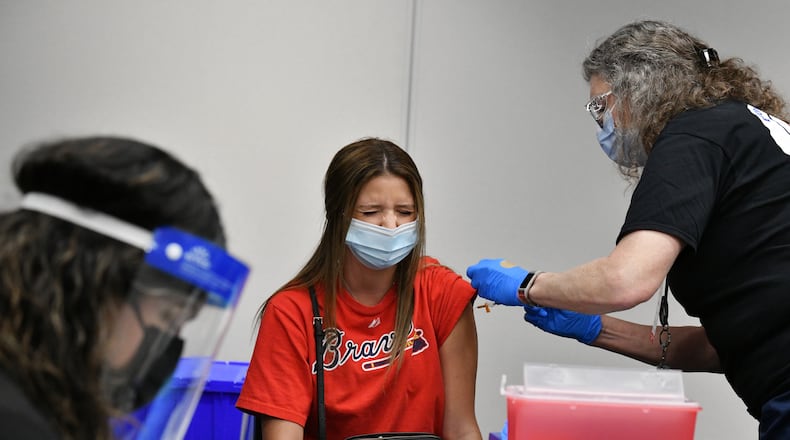Demand for COVID-19 vaccinations has fallen so dramatically in Georgia that the state has been turning down millions of allocated doses, telling the federal government to distribute them elsewhere.
The state has “donated” more than three million of its allotted doses of Pfizer and Moderna COVID-19 vaccines over the past three weeks, the Georgia Department of Public Health (DPH) said Thursday. Of that total, DPH turned down 788,210 on Thursday.
Meanwhile, Georgia has tens of thousands of doses of the Johnson & Johnson vaccine on hand that are in danger of expiring before they can be injected into arms. DPH spokeswoman Nancy Nydam said Wednesday that about 171,500 un-administered J&J vaccines were scheduled to expire before the end of June.
On Thursday, though, amid warnings that supplies across the nation would expire, Johnson & Johnson announced that the U.S. Food and Drug Administration has extended the vaccine’s expiration date by six weeks, based on data from ongoing studies. States have been so slow to use them that the federal government has stopped sending new shipments of J&J vaccines to states, an apparent effort to clear up backlogs.
Both situations in Georgia are in some ways a signal of defeat. They reflect lagging demand for shots, a particular problem here even as the state’s vaccination rate is well below the national average. As of Thursday morning, about 52% of Georgia adults had received at least one dose of COVID-19 vaccine, compared with the 64% national average.
Amber Schmidtke, a public health researcher and former Mercer University professor who tracks Georgia’s epidemic, said while it’s prudent for Georgia not to allow doses to go to waste, it’s also “an admission we don’t have the demand for vaccines here that other states have had.”
“I think other states have been more creative to encourage vaccinations and get the word out,” she said.
For months, Georgia has had one of the higher per capita rates of excess doses in the country and used one of the lowest proportions of its federal allocations. Centers for Disease Control and Prevention data show Georgia has been allocated about 10.9 million doses, meaning Georgia has turned back about 28% of its share.
The declined doses were not ones shipped to providers in Georgia, but were ones Georgia was allotted to receive had demand warranted.
Nydam said those doses aren’t necessarily gone for good.
“Should the situation change in Georgia and we are in need of vaccine,” she said, “we can get them back from the pool — we don’t lose them.”
Credit: Timothy D. Easley / Getty Images
Credit: Timothy D. Easley / Getty Images
A substantial increase in demand doesn’t appear likely, though.
Vaccine demand in Georgia peaked in March with a rolling average of about 50,000 per day, which has dropped to about 14,000 per day, an Atlanta Journal-Constitution analysis shows.
And for Georgia, the extra time on the J&J doses doesn’t mean they will go in arms.
Over the past month, Georgia has administered an average of 1,532 J&J vaccines per day, according to the Centers for Disease Control and Prevention’s vaccine distribution data.
At that rate, it would take Georgia 16 weeks to use up 171,000 doses.
New threat
Though confirmed and suspected infections and hospitalizations are at their lowest points since the start of the pandemic, none of this bodes well for the state’s faltering effort to reach “herd immunity” via vaccination.
Experts differ on what constitutes herd immunity — but most estimate a range of 70% to 90% of the population obtaining protection through the full course of vaccination or prior infection.
Full vaccination is also vital to turning back the new threat from the delta variant, which was first identified in India and has since been detected in Georgia. That variant is believed to be more contagious and severe, and public health officials fear a possible resurgence of the virus via the new variant among those who are unvaccinated or who skip their second shot.
Mass vaccination sites have closed in Georgia, though, and the state has transitioned to relying on a mix of private pharmacies and grocers, medical practices, hospitals, health departments and mobile clinics operated by nonprofit groups, such as the nonprofit Community Organized Relief Effort, to reach the unvaccinated.
Joshua S. Weitz, a professor of biological sciences at Georgia Tech, is part of a team that’s attempted to estimate the level of immunity via prior infection and vaccination in the U.S. and each state. Because of limitations in testing and prevalence of asymptomatic or mildly symptomatic spread, Weitz’s team assumes four infections have occurred for every confirmed infection.
That means in Georgia, it’s plausible about 4 million people have been infected. There’s also likely an overlap in the number of people who were previously infected and those who are vaccinated.
Weitz’s team estimates about 60% of Georgians have some level of immunity. But millions remain unprotected.
Credit: Steve Schaefer for the AJC
Credit: Steve Schaefer for the AJC
If DPH is turning away vaccine doses, that shows state officials themselves may have lost confidence that Georgia’s vaccination pace has any chance of significantly improving, said Eva Lee, a vaccine distribution expert and director of Georgia Tech’s Center for Operations Research in Medicine and Healthcare.
Or that they’re comfortable with the status quo, she said.
“Horrible — this is absolutely not good,” Dr. Lee said. “I think it’s ridiculous, because we’re not there yet.”
Lee said the tiered priority system at the beginning of the vaccine rollout that favored heath care workers and people age 65 and older — which she roundly criticized at the time — left a lot of people shut out of the process, and many may have given up in frustration and decided that if most everyone else is vaccinated, they’re protected too.
DPH teams should put more focus on delivering doses to places where homeless people congregate and impoverished areas of the Appalachian region, doing everything possible to reach people who are unable or unwilling to reach vaccination sites, she said.
The J&J’s vaccine is considered key to reaching such marginalized communities, since its one-and-done formulation doesn’t require bringing people back for a second shot.
Credit: Alyssa Pointer / Alyssa.Pointer@ajc.com
Credit: Alyssa Pointer / Alyssa.Pointer@ajc.com
Mark Rosenberg, a former CDC researcher and former president and CEO of the Task Force for Global Health, said the state should be giving more doses to primary care doctors, who are best positioned to talk patients through their fears and out of any misinformation they’ve heard. But doctors usually have to tell patients that they don’t have the vaccine on hand, themselves.
And the state should offer cash prizes to students and others who come up with innovative ways to get more vaccines into more arms, he said.
“What we can do is think a little further and think outside the box,” Rosenberg said. “And get people to help us think outside the box.”
Data journalist John Perry contributed to this story, which also includes information from the Associated Press.
Keep Reading
The Latest
Featured





